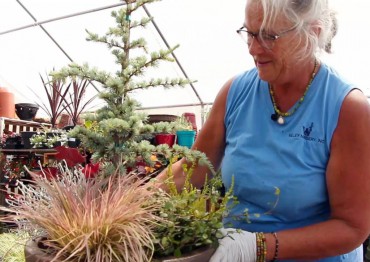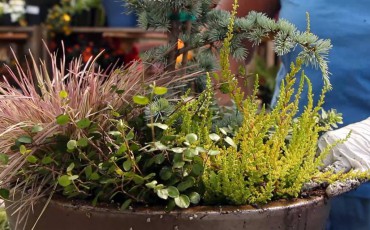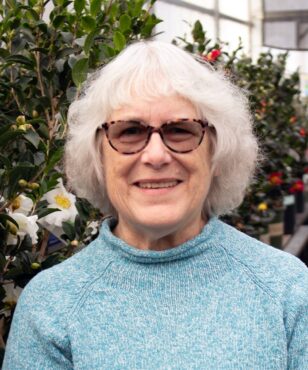Containers packed with plants provide garden pizzazz. Even though this blog and video are about containers for fall to winter enjoyment, they are actually planted up in mid to late summer.
Plants often live happily in containers for anywhere from five to seven years. The methods shown in this video can be applied to containers at any time of year, even when planting annuals for only one-season enjoyment.
Sylvia Smith from Valley Nursery in Poulsbo is known for her container gardens. She agreed to create a fall container for this WSH&G video. Here’s how you too can create an awesome container for all season enjoyment, but especially to take center stage in the fall.

First decide if the container will be viewed from all sides or from only one direction. In the video example, the container can be viewed from all directions. To adapt for viewing from one direction only, the tallest plants would be in the back and the rest would fill in around it.
Select five to seven plants to fill a large container. Choose a tall plant for the center, several plants for filling in around the focal plant and some plants to trail over the edges. Water the plants well before planting.
Fill the container with potting soil. A paper coffee filter can be placed over the drainage holes so soil won’t spill out the bottom. Next fill the container with soil but leave a few inches unfilled at the top.
Start removing the selected plants from their pots, loosen their roots and place them into their resting places in the large container. Once all the plants are containerized, water in thoroughly.
 Small trees sometimes need to be staked for support. Be sure to remove the tightly attached strings, wires or plastic straps though. These are to protect the tree during transport to the nursery.
Small trees sometimes need to be staked for support. Be sure to remove the tightly attached strings, wires or plastic straps though. These are to protect the tree during transport to the nursery.
The stake is only to provide gentle support and needs to be removed after no longer than six months — usually sooner than that.
Watering is usually needed once a week unless the container is placed in a part of the garden that receives regular watering or good rainfall during the rainy season. This type of container planting does not usually need fertilizer. But a diluted liquid fertilizer can be used once a year or so. Most woody plants don’t need fertilizing.
Make sure the container drains properly in its location. Sometimes pot feet will need to be placed under the container. Avoid locating the container where mud or damp soil remains underneath. This condition would cause the roots of the plants to rot and the plants would ultimately die.
Plants will eventually outgrow the container. Check each year to see how the plants are doing. Locate them out into the regular landscaping in the garden when they outgrow the container.
Materials needed:
- Frost- and weather-proof ceramic container with drainage holes in the bottom
- Potting soil — avoid potting mixes with peat or other materials that dry out too rapidly; one example of good potting soil to use is Gardeners Gold Organic Potting Soil
- Plants — combine tall plants along with mounding and trailing plants; choose woody and evergreen plants
Plants used in the video in order of appearance:
- Horstman Blue Atlas Cedar
- Northern Lights tufted hair grass
- Big leaf wire vine (Molumbeckia)
- Heather Spring Torch ‘Firefly’
- Hebe ‘Red Edge’
- Calocephalus brownie (cushion bush)

























